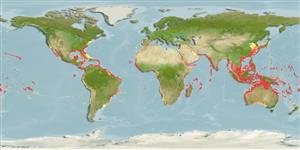分类 / Names
俗名 | 同种异名 | Catalog of Fishes(属, 种) | ITIS | CoL | WoRMS | Cloffa
Environment: milieu / climate zone / depth range / distribution range
生态学
海洋 礁区鱼类; 海洋洄游的 (Ref. 51243); 深度上下限 0 - 1000 m (Ref. 106604). 亞熱帶的; 42°N - 38°S, 180°W - 180°E (Ref. 55255)
Circumglobal, tropical to temperate: in the Northern Hemisphere, as far north as southern California and Rhode Island on the United States west and east coasts, Mutsu Bay, Aomori, Japan, the Sinai Peninsula, Egypt and the Azores Islands; in the Southern Hemisphere, as far south as Peru, Uruguay, South Africa and New Zealand. In
some locations, including Mozambique, it is sympatric with Manta alfredi.
Circumtropical。 西大西洋: 百慕達群島與美國南卡羅萊那州到巴西, 偶然更北方.(參考文獻 26938)
Length at first maturity / 大小 / 重量 / 年龄
Maturity: Lm 422.0, range 380 - 460 cm
Max length : 910 cm WD 雄鱼/尚未辨别雌雄; (Ref. 58048); common length : 450 cm WD 雄鱼/尚未辨别雌雄; (Ref. 3176); 最大体重: 3.0 t (Ref. 5377); 最大年龄: 20 年 (Ref. 31742)
A giant ray having an extremely broad head with long head fins, and a terminal mouth; upper surface of disc covered with denticles, and tail usually without a spine (Ref. 5578). Blackish above, sometimes with white shoulder patches; white below, with grey edging on disc (Ref. 5578). Tail whiplike but short (Ref. 7251).
一个大型的 鱼有一个非常宽大头部有长的头鳍 , 与一个端位口; 体盘上表面覆盖着细齿了,而且尾部通常没有一根棘。 (参考文献 5578) 背面黑色的, 有时具有白色的肩区块; 腹面白色的, 在体盘上有灰色的边.(参考文献 5578) 尾部鞭状的但是短.(参考文献 7251)
Mainly in near-shore waters, near coral and rocky reefs; sometimes found over deep water (Ref. 12951). Reported along productive coastlines with regular upwelling, oceanic island groups and offshore pinnacles and seamounts (Ref. 82755). Penetrates shallow muddy bays and the intertidal and occurs off river mouths (Ref. 9911). Pelagic (Ref. 58302). Occurs singly or in loose aggregations (Ref. 12951). Mainly plankton feeders, but may feed on small and moderate-sized fishes as well (Ref. 9911). Leaps out the water mainly in spring and autumn, possibly as part of mating behavior (Ref. 31742). Easily approached (Ref. 9911). Ovoviviparous (Ref. 6902). Commonly caught by tuna gillnet and harpoon fisheries. Utilized for its gill filter plates (very high value), meat, cartilage and skin (Ref.58048). Liver yields oil and skin used as abrasive (Ref. 6902). World's largest ray (Ref. 37816).
主要在近岸水域, 在珊瑚礁与岩礁的附近; 有时发现在深水域上面了。 (参考文献 12951) 深入泥泞的浅水海湾与潮间带而且出现河口外。 (参考文献 9911) 各别地或在松散的鱼群中生存。 (参考文献 12951) 主要地浮游生物捕食者, 但是可能吃小的与也中等大小的鱼.(参考文献 9911) 出自水的跳跃主要在春天与秋天, 可能地为交配行为的一部份.(参考文献 31742) 容易接近。 (参考文献 9911) 卵胎生的.(参考文献 6902) 肝脏产生油,而且皮肤用作了研磨剂。 (参考文献 6902) 世界最大的鳍条.(参考文献 37816)
Life cycle and mating behavior
成熟度 | 繁殖 | 产卵场 | 卵 | 孕卵数 | 仔鱼
Exhibit ovoviparity (aplacental viviparity), with embryos feeding initially on yolk, then receiving additional nourishment from the mother by indirect absorption of uterine fluid enriched with mucus, fat or protein through specialised structures (Ref. 50449). Bears up to 2 young (Ref. 5578); born at 122-127 cm WD (Ref.58048). A female of 550 cm width and weighing 1050 kg was collected in the Galapagos in June and was carrying a well-developed embryo of 12.7 kg (Ref. 28023). Size at partuition might be from 1.1 to 1.3 m and from 9.1 to 1.14 kg (Ref. 31742).
Yano et al (1999) (Ref. 35892) describe the mating behavior of manta rays based on observations off Ogasawara Islands, Japan, in the following sequence:
1) 'chasing', the male rapidly follows behind the tail of the female and attacks her several times;
2) 'nipping', the male nips the tip of the pectoral fin of the female and then moves to the ventral surface of the female;
3) 'copulating', the male inserts a clasper into the cloacaof the female and copulates abdomen-to-abdomen, up to 123 seconds;
4) 'post-copulating';
5) 'separating'. (Ref. 49562).Circumtropical。 西大西洋: 百慕達群島與美國南卡羅萊那州到巴西, 偶然更北方.(參考文獻 26938)
Last, P.R. and J.D. Stevens, 1994. Sharks and rays of Australia. CSIRO, Australia. 513 p. (Ref. 6871)
世界自然保护联盟红皮书 (Ref. 130435: Version 2024-2)
濒危 (EN) (A2bcd+3d); Date assessed: 12 November 2019
人类利用
渔业: 低经济
工具
特别资料
下载 XML
网络资源
Estimates based on models
Preferred temperature (Ref.
123201): 22.8 - 29, mean 27.6 °C (based on 3220 cells).
Phylogenetic diversity index (Ref.
82804): PD
50 = 0.5005 [Uniqueness, from 0.5 = low to 2.0 = high].
Bayesian length-weight: a=0.01000 (0.00244 - 0.04107), b=3.04 (2.81 - 3.27), in cm total length, based on all LWR estimates for this body shape (Ref.
93245).
营养阶层 (Ref.
69278): 3.5 ±0.50 se; based on food items.
Generation time: 7.3 ( na - na) years. Estimated as median ln(3)/K based on 2
growth studies.
回复力 (Ref.
120179): 非常低的, 最小族群倍增时间超过14 年 (tm=6; tmax>20; Fec=1).
Fishing Vulnerability (Ref.
59153): High vulnerability (63 of 100).
Nutrients (Ref.
124155): Calcium = 2.4 [0.4, 10.8] mg/100g; Iron = 0.339 [0.080, 0.946] mg/100g; Protein = 23 [18, 28] %; Omega3 = 0.1 [0.0, 0.4] g/100g; Selenium = 26.2 [7.4, 97.2] μg/100g; VitaminA = 10.6 [3.1, 37.8] μg/100g; Zinc = 0.305 [0.144, 0.613] mg/100g (wet weight);
